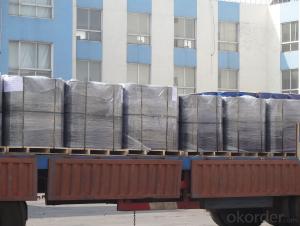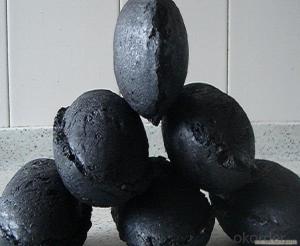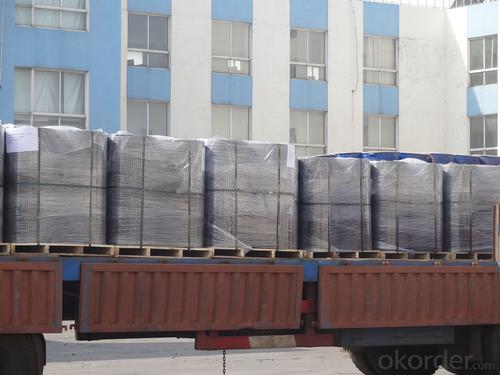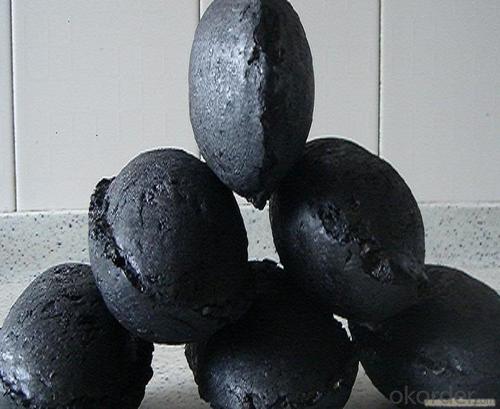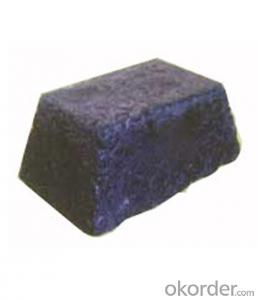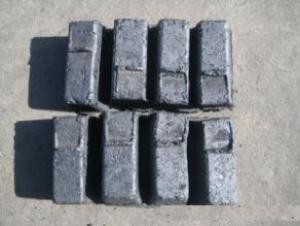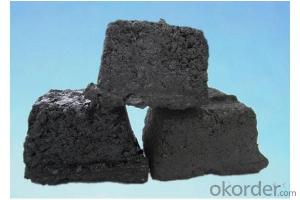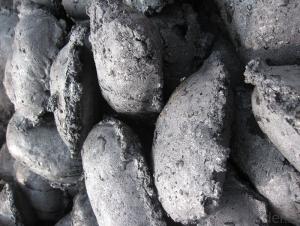All type Low Ash Carbon Electrode Paste Block High Quality
- Loading Port:
- Tianjin
- Payment Terms:
- TT OR LC
- Min Order Qty:
- 0 m.t.
- Supply Capability:
- 20000 m.t./month
OKorder Service Pledge
OKorder Financial Service
You Might Also Like
Introduction To Products
1) Carbon Electrode Paste is a self-baking electrode used in submerged arc furnaces for delivering power to the charge mix.
2) Electrode Paste is added to the top of the electrode column in either cylindrical or briquette form.
3) As the paste moves down the electrode column the temperature increase causes the paste to melt and subsequently bake
forming a block of electrically conductive carbon.
4) Electrode Paste is essentially a mix of Electrically Calcined Anthracite (ECA) or Calcined Petroleum Coke (CPC) with Coal
Tar Pitch.
Application Range
1) Be used as the electrode for self roasting in the iron-alloy furnace and acetylene furnace.
2) Amorphous graphite powder--applied in steel making,fireproof material,casting coating.
3) Calcined petroleum coke--used in foundry,metallurgy,carbon paste,graphite electrode.
4) Carbon anode scrap--used as smelting fuel for copper smelting industry.
5) Carbon electrode paste--applied in iron alloy,calcium carbide,ferroalloy,ferromanganese.
Features
1:carbon eletrode paste
2:for ferroalloy,calcium carbide manufacture
3:HS 3801300000,YB/T5212-1996,ISO9001:2008
Graphite/Carbon Electrode Paste
Specification/Item |
|
|
|
|
|
|
Ash | 4.0%max | 5.0%max | 6.0%max | 7.0% Max | 9.0% Max | 11.0% Max |
VM | 12.0%-15.5% | 12.0%-15.5% | 12.0%-15.5% | 9.5.0%-13.5% | 11.5%-15.5% | 11.5%-15.5% |
Compress Strength | 18.0Mpa Min | 17.0Mpa Min | 15.7Mpa Min | 19.6Mpa Min | 19.6Mpa Min | 19.6Mpa Min |
Specific Resistance | 65μΩm Max | 68μΩm Max | 75μΩm Max | 80μΩm Max | 90μΩm Max | 90μΩm Max |
Bulk Density | 1.38G/CM3 Min | 1.38G/CM3 Min | 1.38G/CM3 Min | 1.38G/CM3 Min | 1.38G/CM3 Min | 1.38G/CM3 Min |
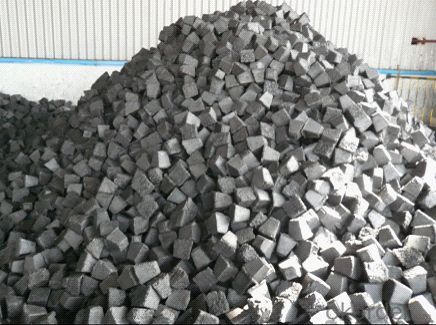
- Q: How does carbon impact the ozone layer?
- Carbon does not directly impact the ozone layer. However, carbon compounds such as chlorofluorocarbons (CFCs), which contain carbon, can have a significant impact on the ozone layer. When released into the atmosphere, CFCs can reach the stratosphere where they are broken down by ultraviolet (UV) radiation and release chlorine atoms. These chlorine atoms then catalytically destroy ozone molecules, leading to the depletion of the ozone layer. The destruction of the ozone layer is a critical environmental issue as it allows more harmful UV radiation from the sun to reach the Earth's surface. Increased UV radiation can have detrimental effects on human health, including skin cancer, cataracts, and weakened immune systems. It can also harm ecosystems by damaging phytoplankton, which are crucial for the marine food chain, and affecting the growth of plants and crops. To combat this problem, the international community has taken steps to reduce the production and use of ozone-depleting substances, including CFCs. The Montreal Protocol, an international environmental agreement, has been successful in phasing out the production of CFCs and other harmful substances. This has contributed to the recovery of the ozone layer, although it is still a long-term process. In conclusion, carbon itself does not directly impact the ozone layer. However, carbon compounds like CFCs, which are released into the atmosphere, can lead to the destruction of the ozone layer. Efforts to reduce the production and use of these ozone-depleting substances have been crucial in protecting the ozone layer and mitigating the harmful effects of increased UV radiation.
- Q: How does carbon affect the formation of tsunamis?
- Carbon does not directly affect the formation of tsunamis. Tsunamis are typically caused by underwater earthquakes, volcanic eruptions, or landslides, which are not influenced by carbon. However, carbon emissions and climate change can indirectly impact the frequency and intensity of natural disasters, including some potential triggers for tsunamis, such as volcanic activity or landslides near coastlines.
- Q: What is carbon?
- Carbon is a chemical element that is essential for life on Earth. It is found in all living organisms and is the building block for the organic compounds that make up our bodies, such as proteins, carbohydrates, lipids, and nucleic acids. Carbon is also a key component of the Earth's atmosphere, where it exists mainly as carbon dioxide. It is present in various forms, including graphite and diamonds, and has the ability to form strong bonds with other elements, making it incredibly versatile. Carbon plays a crucial role in many natural processes, such as photosynthesis, respiration, and the carbon cycle, which helps regulate the Earth's climate. It is also widely used in industry, serving as a raw material for the production of fuels, plastics, and countless other products. Overall, carbon is a fundamental element that is vital for sustaining life and driving various chemical and biological processes.
- Q: What are the impacts of carbon emissions on the stability of river ecosystems?
- Carbon emissions have significant impacts on the stability of river ecosystems. One of the primary consequences of carbon emissions is the increase in greenhouse gases in the atmosphere, leading to global warming. Rising temperatures have direct and indirect effects on river ecosystems. Firstly, increased temperatures can alter the physical characteristics of rivers and affect the availability of oxygen in the water. Warmer water holds less dissolved oxygen, which can harm aquatic organisms such as fish and invertebrates that rely on oxygen for survival. This decrease in oxygen levels can lead to reduced biodiversity and even fish kills. Secondly, climate change, driven by carbon emissions, can disrupt the natural hydrological cycle. Changes in precipitation patterns can result in droughts or floods, causing fluctuations in river flow. These changes can affect the spawning and migration patterns of many aquatic species, disrupting their life cycles and reducing their populations. Furthermore, altered river flows can also impact the stability of riverbank and riparian habitats, leading to erosion and habitat loss. Additionally, increased carbon emissions contribute to ocean acidification. When carbon dioxide is absorbed by water, it forms carbonic acid, which lowers the pH of the water. Acidic waters can have detrimental effects on aquatic life, including shellfish, corals, and other calcifying organisms. River ecosystems are interconnected with coastal and marine ecosystems, so the impacts of ocean acidification can indirectly affect river ecosystems through the food web. Moreover, carbon emissions contribute to the deposition of air pollutants, such as nitrogen and sulfur compounds, onto land and water bodies. These pollutants can be transported by rainfall into rivers, leading to increased nutrient levels and eutrophication. Excessive nutrients can cause harmful algal blooms, deplete oxygen levels, and create dead zones, further disrupting the balance of river ecosystems. In conclusion, carbon emissions have profound impacts on the stability of river ecosystems. Rising temperatures, altered hydrological cycles, ocean acidification, and increased nutrient levels all contribute to the degradation of these ecosystems. It is crucial to reduce carbon emissions and implement sustainable practices to mitigate these impacts and preserve the health and stability of river ecosystems.
- Q: How is carbon involved in the metabolism of carbohydrates, proteins, and fats?
- The metabolism of carbohydrates, proteins, and fats relies heavily on carbon, a fundamental element. Within all three macronutrients, carbon atoms play a vital role in forming their molecular structures. Carbohydrates contain carbon in the form of glucose, which serves as the body's primary energy source. Through glycolysis, glucose is broken down into smaller molecules, generating ATP for cellular energy. Carbon atoms in glucose are rearranged and converted into intermediate compounds, which are further utilized in other metabolic pathways. In contrast, proteins are intricate molecules made up of amino acids, each containing a carbon atom. During protein metabolism, carbon atoms participate in various reactions, including deamination and transamination, enabling the synthesis or breakdown of proteins. Carbon atoms also contribute to the formation of peptide bonds, linking amino acids together to create the backbone of proteins. In the metabolism of fats or lipids, carbon is predominantly found in the fatty acid chains. These chains provide a high-energy fuel source, as they can be broken down through beta-oxidation. Sequential cleavage of carbon atoms from fatty acids produces acetyl-CoA, which enters the citric acid cycle (also known as the Krebs cycle) to generate ATP. Furthermore, carbon atoms from fatty acids can be utilized for the synthesis of other molecules, such as cholesterol and hormones. In summary, carbon plays a crucial role in the metabolism of carbohydrates, proteins, and fats. Its involvement in these metabolic processes facilitates energy production, the synthesis and breakdown of essential molecules, and the regulation of various physiological functions.
- Q: Last night to go to the supermarket to buy 5 batteries, see Toshiba carbon batteries, I finally bought the super alkaline batteries, alkaline batteries and carbon is the difference in where? What kind of battery is best for digital cameras? Thank you
- Alkaline battery discharge point, carbon battery's full name should be carbon zinc batteries (because it is the general level is the carbon rod electrode is the zinc skin), also known as zinc manganese battery, is currently the most common dry battery, it has the characteristics of low price and safe and reliable use, environmental factors based on the consideration.
- Q: How do you remove the carbon stains on your clothes?
- Cleaning instructions for clothing * collar / cuff: Soak clothes in warm water with detergent powder for 15-20 minutes before washing. * Yellow White Sox: soaking washing powder for 30 minutes, then normal washing. * milk stains: use washing powder to do stain pretreatment and normal washing. If the milk stains are stubborn, you may need to use a bleach that is harmless to the clothes. * ordinary oil: a strong detergent is used for pre treatment and normal washing; if desired, bleaching of stubborn stains can also be done with bleach. The clothing removal method of rubber and plastic sex pigment stains with rubber and plastic pigment stains, it is difficult to remove, only use a suitable way to remove. 1, adhesive removal of stains clothes with glue stains, can use acetone or banana on glue water stains, use a brush to repeated washing, until soft glue stains off from the fabric, and then rinse with water. Once, can be repeated scrubbing several times, and finally wash. Do not use this method to avoid fabric damage. 2, white latex stain removal of white latex is a kind of synthetic resin, polyvinyl acetate emulsion. It is characterized by the addition of nylon silk and so on, the vast majority of fiber quality materials have bonding role, it can firmly adhere to the clothing. It has another characteristic that can dissolve in a variety of solutions. We will use its own characteristics to find ways to remove. By 60 DEG C or 8:2 alcohol liquor (95%) and a mixture of water, white glue stains on the clothes soak, soak about half an hour later, you can wash with water scrubbing, until...
- Q: Who can explain that bare feet on fire carbon don't burn feet?
- The fire is red carbon, but no signs of fire and water after scald. Actually, that's a very simple physical phenomenon. The most mysterious matter where we can buy, can make the carbon fire red instantly cool, people ran fast, naturally not hurt hair.These two substances, one is white borax, and the other is red cinnabar (also known as cinnabar). It turns out that the crystals are dissolved because they absorb large amounts of heat. When borax or cinnabar scattered on the surface of carbon fire, because the heat will make the wood surface temperature drop.
- Q: How dnf advanced carbon ashes?
- That thing is called the advanced furnace rock carbon... Not ash carbon...... It was bought at the mall (sold before, no now), with a success rate plus ten percent.
- Q: How does carbon impact the quality of freshwater systems?
- Carbon can have a significant impact on the quality of freshwater systems. One of the main ways carbon affects these systems is through the process of carbon dioxide (CO2) emissions. When excess CO2 is released into the atmosphere, it can dissolve in rainwater and form carbonic acid. This acidification of freshwater bodies can lower the pH levels, making the water more acidic. High levels of acidity can be detrimental to many freshwater organisms, including fish, amphibians, and invertebrates. It can disrupt their reproductive systems, impair their growth and development, and even lead to the death of these organisms. Additionally, increased acidity can also affect the availability of essential nutrients in the water, further impacting the health and survival of aquatic life. Another way carbon impacts freshwater systems is through the process of eutrophication. Excess carbon can enter freshwater bodies through runoff from agricultural fields or wastewater treatment plants. This excess carbon acts as a nutrient, fueling the growth of algae and other aquatic plants. As these plants proliferate, they can create dense mats on the water's surface, blocking sunlight and depleting oxygen levels. The depletion of oxygen can lead to hypoxia, a condition where oxygen levels become dangerously low, resulting in the death of fish and other organisms. Additionally, the excess growth of algae can lead to algal blooms, which can release toxins into the water, further impacting the quality of freshwater systems. Furthermore, carbon can also impact the temperature of freshwater systems. Increased levels of carbon dioxide in the atmosphere contribute to global warming, which raises the overall temperature of the planet. As a result, freshwater systems may experience higher water temperatures, leading to changes in the ecosystem. Some species may struggle to adapt to these warmer conditions, while others, such as invasive species, may thrive. In conclusion, carbon has a significant impact on the quality of freshwater systems. It can lead to acidification, eutrophication, and changes in temperature, all of which have detrimental effects on the health and survival of aquatic organisms. Addressing carbon emissions and reducing our carbon footprint is crucial in protecting the integrity of freshwater systems and ensuring their long-term sustainability.
Send your message to us
All type Low Ash Carbon Electrode Paste Block High Quality
- Loading Port:
- Tianjin
- Payment Terms:
- TT OR LC
- Min Order Qty:
- 0 m.t.
- Supply Capability:
- 20000 m.t./month
OKorder Service Pledge
OKorder Financial Service
Similar products
Hot products
Hot Searches
Related keywords
